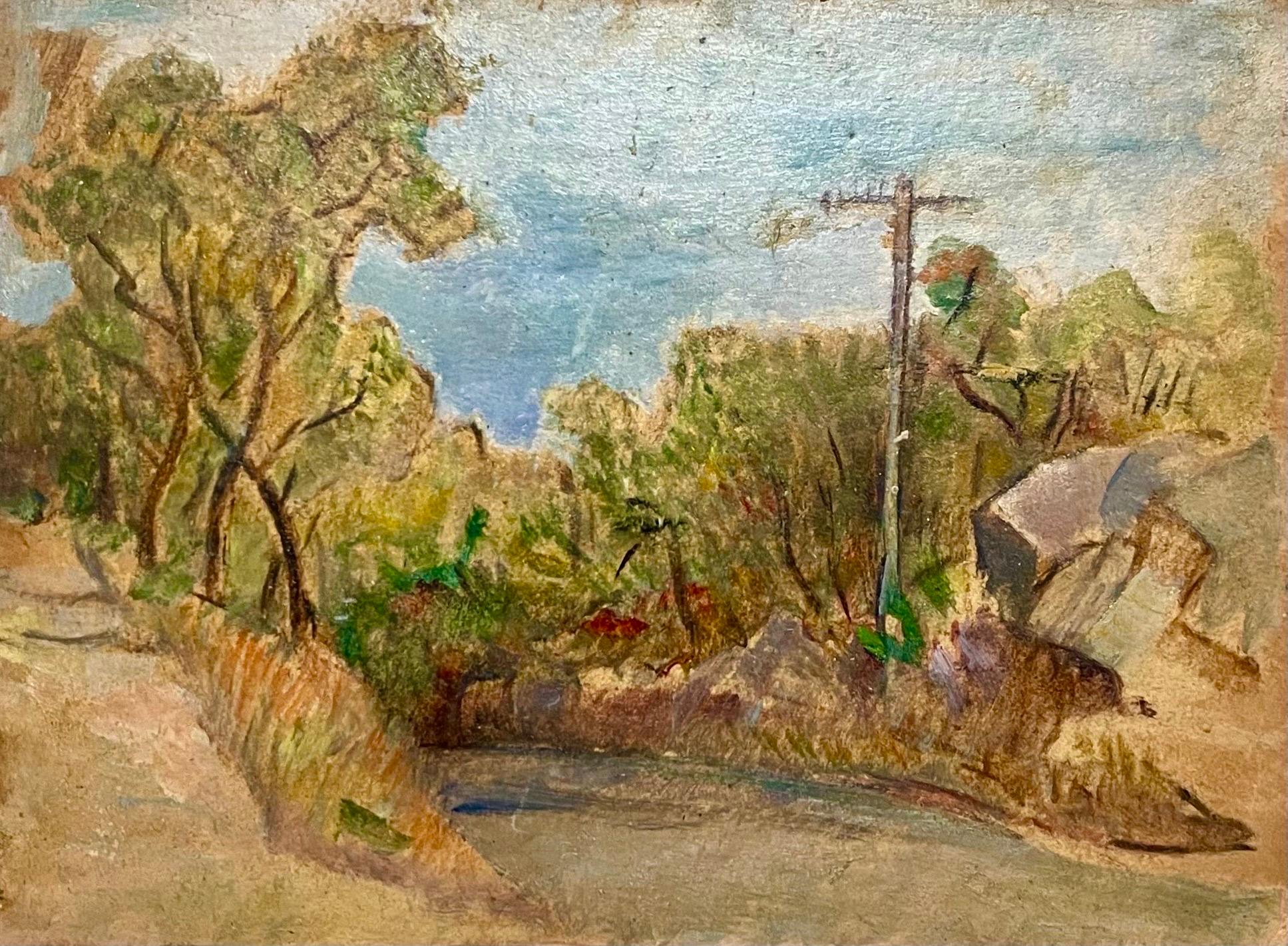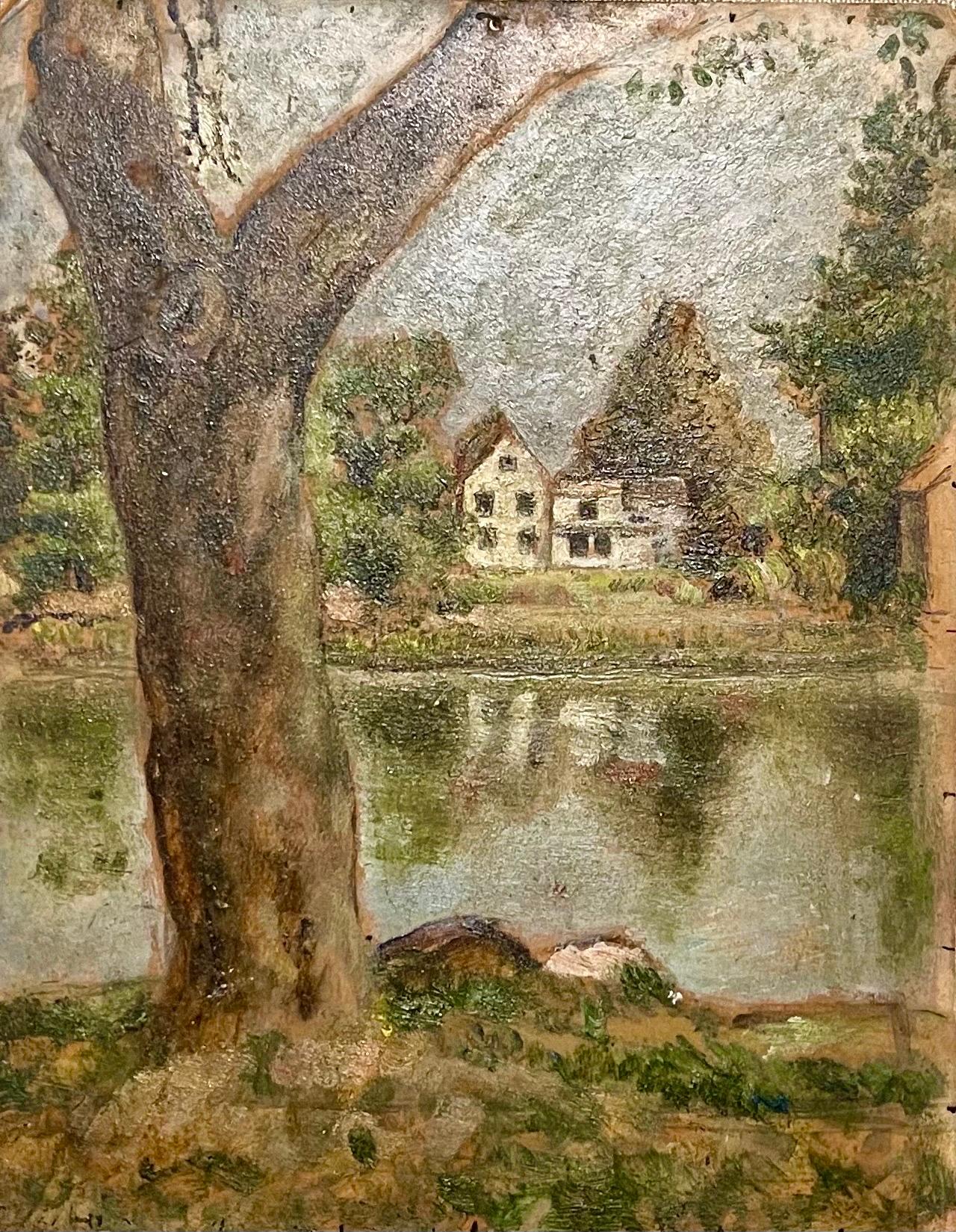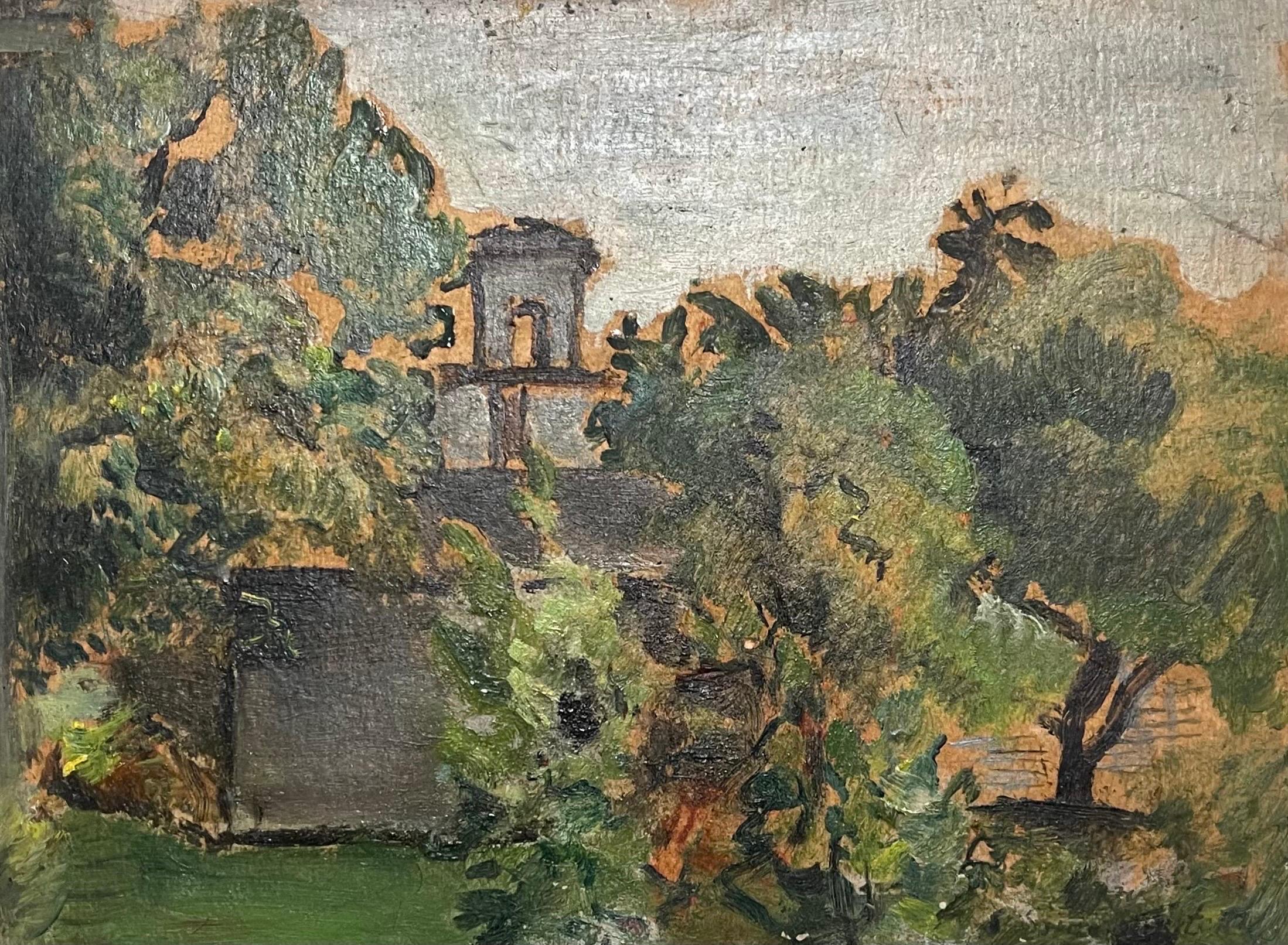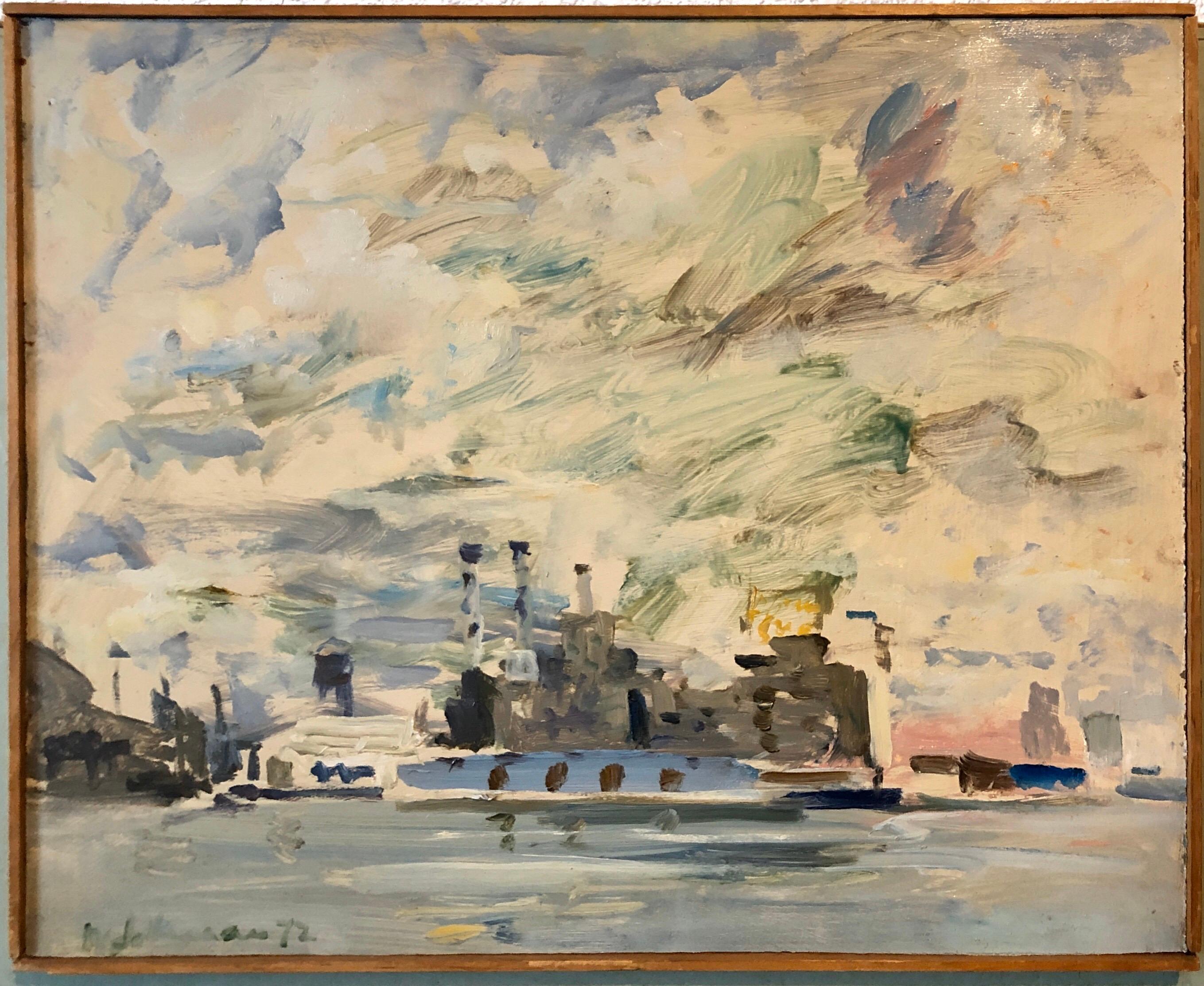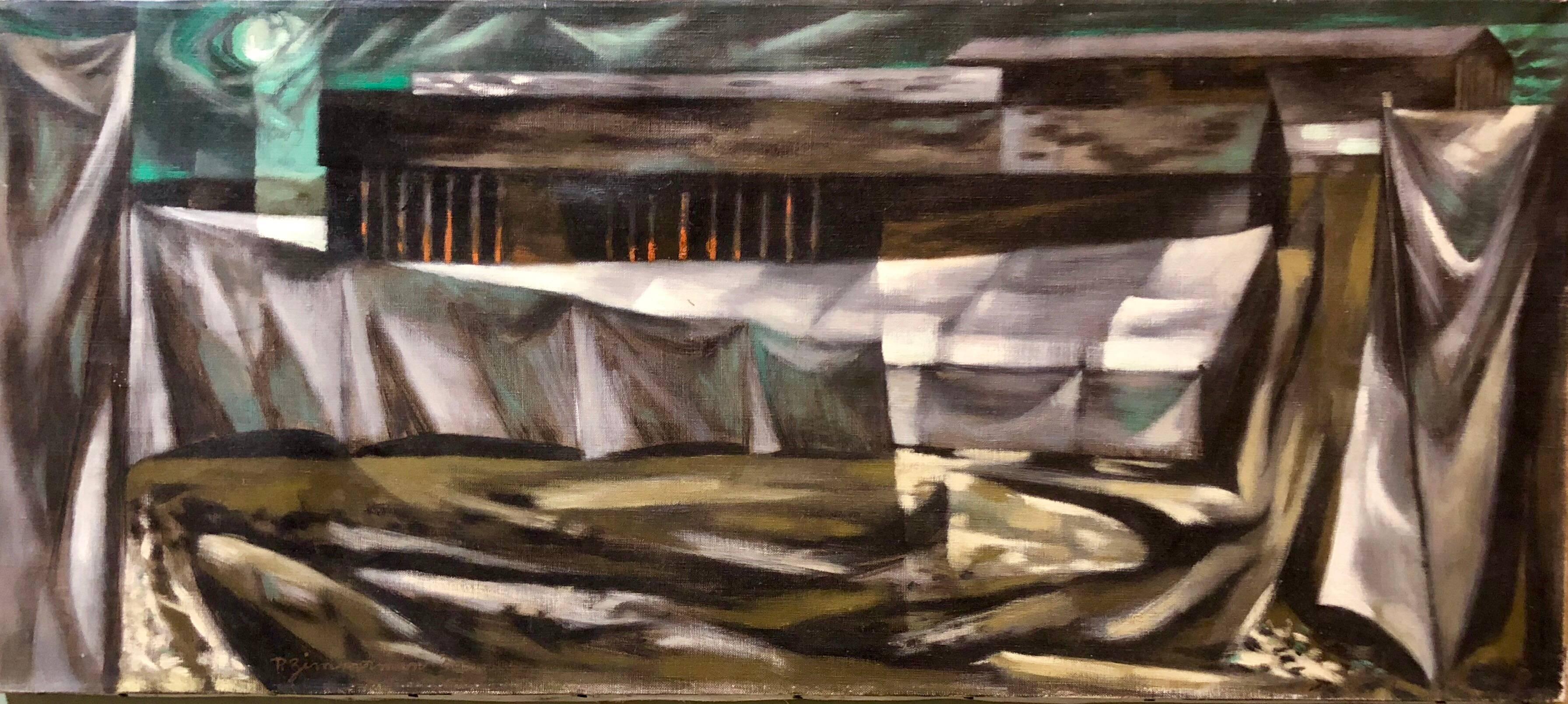Items Similar to WATTS TOWER
Want more images or videos?
Request additional images or videos from the seller
1 of 15
Gloria StuartWATTS TOWER1971
1971
About the Item
GLORIA STUART (1910 – 2010)
WATTS TOWERS, 1971
Oil on canvas, signed lower right, 24” x 50 ½”. Gloria Stuart, an Academy Award nominated actress was also a painter, illustrator and printmaker. She most recently portrayed Rose in the blockbuster film “Titanic”. She was a Santa Monica native.
In 2013 The Los Angeles Museum of Art, LACMA exhibited a nearly identical painting looking from the south, the same size and frame. Last 5 photos show the example at LACMA. One shows theirs in a distant room with a major Thomas Hart Benton painting in the foreground
A VERY IMPORTANT MULTI-LEVELED DOCUMENT OF LOS ANGELES AND HOLLYWOOD CULTURAL HSTORYi
The following is from her obituary in the Los Angeles Times upon her death in September 2010 at the age of 100
Gloria Stuart, a 1930s Hollywood leading lady who earned an Academy Award nomination for her first significant role in nearly 60 years — as Old Rose, the centenarian survivor of the Titanic in James Cameron’s 1997 Oscar-winning film — has died. She was 100.
.......She devoted much of her time to designing and printing artists’ books (handmade, letter-press printed books in limited editions, with her own artwork and writing). Her work is in the J. Paul Getty Museum in Los Angeles, the Metropolitan Museum of Art in New York City, the Victoria and Albert Museum in London and other museums.
Stuart, a founding member of the Screen Actors Guild who later became an accomplished painter and fine printer, died Sunday night at her West Los Angeles home, said her daughter, writer Sylvia Thompson.
Stuart had been diagnosed with lung cancer five years ago.
“She also was a breast cancer survivor,” Thompson said, “but she just paid no attention to illness. She was a very strong woman and had other fish to fry.”
In July the actress was honored at an “Academy Centennial Celebration With Gloria Stuart” at the Samuel Goldwyn Theater in Beverly Hills.
“She was a charming and beautiful leading lady in the ‘30s, and I never understood why her career didn’t go further at that time,” film historian and critic Leonard Maltin, who interviewed Stuart on stage at the event, told The Times on Monday.
As for Stuart’s high-profile comeback in “Titanic”: “She was thrilled by the attention that that performance brought her and really wanted to win that Oscar. I thought she hit just the right notes in that performance. She was wry and engaging.”
As a glamorous blond actress under contract to Universal Studios and 20th Century Fox in the 1930s, Stuart appeared opposite Claude Rains in James Whale’s “The Invisible Man” and with Warner Baxter in John Ford’s “The Prisoner of Shark Island.”
She also appeared with Eddie Cantor in “Roman Scandals,” with Dick Powell in Busby Berkeley’s “Gold Diggers of 1935” and with James Cagney in “Here Comes the Navy.” And she played romantic leads in two Shirley Temple movies, “Poor Little Rich Girl” and “Rebecca of Sunnybrook Farm.”
But mostly she played what Stuart later dismissed as “stupid parts with nothing to do” — “girl reporter, girl detective, girl nurse” — and “it became increasingly evident to me I wasn’t going to get to be a big star like Katharine Hepburn and Loretta Young.”
After making 42 feature films between 1932 and 1939, Stuart’s latest studio contract, with 20th Century Fox, was not renewed. She appeared in only four films in the 1940s and retired from the screen in 1946.
By 1974, “the blond lovely of the talkies” had become an entry in one of Richard Lamparski’s “Whatever Happened to” books.
Writer-director Cameron’s $200-million “Titanic” changed that.
Stuart played Rose Calvert, the 100-year-old Titanic survivor who shows up after modern-day treasure hunters searching through the wreckage of the sunken ship find a charcoal drawing of her wearing a priceless blue diamond necklace.
Stuart’s performance as Old Rose frames the 1997 romantic- drama that starred Leonardo DiCaprio as lower-class artist Jack Dawson and Kate Winslet as the upper-class young Rose.
In “Gloria Stuart: I Just Kept Hoping,” her 1999 autobiography, Stuart said that after reading the script, “I knew the role I had wanted and waited for all these many years had arrived! I could taste the role of Old Rose!”
Cameron told The Times in a 1997 interview that he chose Stuart because he was “looking for a pro from the ‘30s or ‘40s, someone probably retired, maybe off the Hollywood radar for awhile.”
“I had to have someone who’d play the latter part of the life of someone we’d recognize, Kate Winslet, so it couldn’t be someone like Katharine Hepburn. We know so well what she looked like [when she was young],” Cameron said. “Gloria had just enough distance, and she gave this fantastic reading.”
At 87, Stuart became the oldest actress ever nominated for an Academy Award.
In addition to Oscar and Golden Globe nominations, she won a Screen Actors Guild award for outstanding performance by a female actor in a supporting role (tying with eventual Oscar-winner Kim Basinger for “L.A. Confidential”).
In the multiple-Oscar-winning blockbuster’s wake, Stuart found herself swamped with fan mail and interview requests. She also was faced with being recognized in the supermarket and finding her old films resurfacing on television. People magazine even named her one of the 50 most beautiful people in the world.
In 2000, several hundred fans gathered on Hollywood Boulevard next to the Egyptian Theater for the unveiling of Stuart’s star on the Hollywood Walk of Fame.
“I cannot begin to tell you how rewarding and nourishing and warming it is,” she said at the ceremony. “I wake up every day and say, ‘What a wonderful life. How lucky I am.’ ”
A third-generation Californian, she was born Gloria Stewart in Santa Monica on the Fourth of July, 1910. She later changed the spelling of her last name to Stuart, reasoning that the six letters would balance perfectly on a theater marquee with the six letters in “Gloria.”
In high school, she took classes in short-story and poetry-writing and worked for free as a “girl reporter” at the Santa Monica Outlook.
While attending UC Berkeley, where she acted in a campus theatrical group, Stuart met a handsome young sculptor, Gordon Newell. They were married in 1930 and moved to Carmel, where she worked on the local newspaper and appeared in little theater productions.
In 1932, after playing Masha in a little theater production of Chekhov’s “The Seagull” in Carmel, the visiting director asked her to play the role again in a small theater in the Los Angeles area.
Casting directors from both Paramount and Universal saw her performance and offered her screen tests. She wound up signing a seven-year contract with Universal: $125 a week to start, with singing and acting lessons included.
Stuart’s union activities began while making Whale’s 1932 horror comedy “The Old Dark House” with Boris Karloff and Melvyn Douglas.
“All of us were just exhausted by the long hours, and Melvyn Douglas leaned over to me in this theatrical way,” she recalled in a 1998 Los Angeles Times interview. “He whispered the word ‘union’ in my ear. And I thought, ‘Yes!’ ”
At the time, she wrote in her autobiography, “Actors worked unconscionable hours — especially females, because every morning our needs included a great deal of time in hairdressing and makeup. Meals were served at the convenience of the production staff. There was no allotment for travel time, no standard hours between work calls, no pay for overtime or double overtime — what we call golden time. And if an actor under contract refused a role the studio had chosen, he/she was suspended without pay — and the time was added on to the contract!”
Despite stiff studio resistance, the Screen Actors Guild was founded in 1933.
Discovering that she “took to politics like a duck to water,” Stuart helped form the Hollywood Anti-Nazi League in 1936, the same year she and writer Dorothy Parker helped organize the League to Support the Spanish War Orphans. She also became a member of the Hollywood Democratic Committee and was on the executive board of the California State Democratic Committee.
Stuart’s fledgling movie career took a toll on her marriage to Newell and they divorced. In 1934, she married screenwriter Arthur Sheekman, with whom she had her daughter Sylvia.
Stuart, whose career at Universal failed to take off, signed with 20th Century Fox in 1935.
After Fox declined to renew her contract in 1939, she acted in summer theater on the East Coast and made a failed attempt at Broadway before returning to Hollywood and turning her creative energies into the art of decoupage. She opened a shop on La Cienega Boulevard called Décor Ltd., which lasted more than four years.
In 1954, inspired by an exhibition of Impressionist paintings in Paris, she began painting. Her first one-woman show, at the Hammer Galleries in New York in 1961, was a critical hit. Art News called her “a deft primitive with a beguiling variety of subjects.” She went on to have exhibits in major galleries.
In 1975, four years after her husband was stricken with Alzheimer’s disease, Stuart decided to return to acting. From 1975 to 1988, she had about a dozen minor roles on TV and in movies, including dancing with Peter O’Toole in a nightclub scene in the 1982 film “My Favorite Year.”
As her husband became ill, Stuart began taking classes in bonsai. She became an honored member of local bonsai clubs, and her trees are in the bonsai collection at the Huntington Library, Art Collections and Botanical Gardens in San Marino.
Five years after Sheekman’s death in 1978, Stuart renewed a friendship with an old friend from her college years: Ward Ritchie, who had become a world-renowned master printer. The friendship quickly grew into an autumn romance. From Ritchie, Stuart developed an interest in fine letter-press printing and bought her own hand press.
She devoted much of her time to designing and printing artists’ books (handmade, letter-press printed books in limited editions, with her own artwork and writing). Her work is in the J. Paul Getty Museum in Los Angeles, the Metropolitan Museum of Art in New York City, the Victoria and Albert Museum in London and other museums.
About four months after Ritchie’s death in 1996 at 91, Stuart received a call from James Cameron’s casting director, Mali Finn.
“The next day, Jim came with a video camera,” Stuart told The Times in 1997. “I read for him for about an hour, then I didn’t hear anything, so I wrote him a letter and said, ‘I’ve re-read the script and I should’ve given it a feistier reading.’ I mailed it on Friday and Monday Mali Finn called and said, ‘How would you like to be Old Rose?’ I screamed and hollered.”
Besides her daughter, Stuart is survived by four grandchildren and 12 great-grandchildren.
A private funeral service will be held.
- Creator:Gloria Stuart (1910-2010, American)
- Creation Year:1971
- Dimensions:Height: 24 in (60.96 cm)Width: 45 in (114.3 cm)
- Medium:
- Movement & Style:
- Period:
- Condition:
- Gallery Location:Santa Monica, CA
- Reference Number:1stDibs: LU411312217662
About the Seller
5.0
Recognized Seller
These prestigious sellers are industry leaders and represent the highest echelon for item quality and design.
Platinum Seller
These expertly vetted sellers are 1stDibs' most experienced sellers and are rated highest by our customers.
Established in 1977
1stDibs seller since 2016
264 sales on 1stDibs
Typical response time: <1 hour
Associations
International Fine Print Dealers Association
- ShippingRetrieving quote...Ships From: Santa Monica, CA
- Return PolicyA return for this item may be initiated within 7 days of delivery.
More From This SellerView All
- SURREALIST LANDSCAPEBy Edward HagedornLocated in Santa Monica, CAEDWARD HAGEDORN (AMERICAN 1902 – 1982) SURREAL LANDSCAPE 1931 mixed media on paper, Graphite, ink and watercolor. Unsigned. Dtaed 2/26/31, in ink lower left margin. Image 13 3/4 x 16 1/2 inches. On a large sheet 20 x 25 inches. Provenance: Hagedorn estate, Around the mid 1980's The Hagedorn estate was dispersed in Berkeley by a local dealer. This drawing was part of a group of Hagedorn works on paper that I acquired from that dispersal. Much of the balance was later acquired the Struart Denenberg Fine Art. Denenberg published a very fine book on the artist's work. EDWARD HAGEDORN: CALIFORNIA MODERNIST, RESTLESSNESS AND RESTRAINT Hardcover – January 1, 2009 Subsequently Hagedorn's works on paper have been acquired by many museums and some accompanying exhibitions. ALL OF THE COMMENTS BELOW ARE FROM THE FOLLOWING EXHIBITION EDWARD HAGEDORN (1902-1982) American Modernist A New Traveling Exhibition “VOLCANOS, WRECKS, RIOTS, & NUDES”, EDWARD HAGEDORN (1902-1982) premiere at the Danforth Museum. Framingham, MA, in March 2016. The exhibition includes 75 works of art in various mediums and is accompanied by the first monograph devoted to the artist’s work with essays by leading curators, critics, and art historians. Edward Hagedorn was a true Modernist who created a trove of powerful works on paper--drawings, watercolors, oils, and original graphics that reveal the hand of a master draftsman and the mind of an astute political observer. He rejected the general trend in early 20th century California of local landscapes and coastal views, becoming virtually the single voice of Expressionism. He conveyed the darkness and upheaval that gripped the country in the depression years between the two World Wars, 1925- 1935, more forcefully than any of his contemporaries, influenced by German art of the time, engaging in modernist styles of Expressionism and Surrealism. Hagedorn’s skeletons are ferocious yet somehow endearing; printed in deep black ink on off-white paper, they march across Lilliputian landscapes of grim disorder and destruction. Comets and volcanoes explode in fauvist colors, their other-worldly fluorescent temperas framed in black, while nude female figures, executed in exquisitely refined pen and ink, or graphite line drawings, are as economical in their means as Matisse, and can be compared with the neo-classical drawings of Picasso. Among his most lyrical works of the 1920s is a series of rhythmically abstracted watercolor and ink views of Golden Gate Park, evoking the sensual demi-geometries of Balthus, Derain , and early Mondrian. American Modernist Edward Hagedorn (1902-1982) was born in San Francisco of German descent; his mother (née Kafka) died in childbirth, and he was legally adopted and raised by his grandmother and aunt. After attendance at the San Francisco School of Fine Arts in the early 1920s, by age 22 he had a studio in the famed "100" block of Montgomery Street ("the Monkey Block,") then a haven for bohemians. In 1926, a year of tremendous importance in California artists' embrace of modern art, the Oakland Art Gallery, with the guidance and inspiration of their European representative Emmy (Galka) Scheyer, was the first museum in the United States to show the art of the "Blue Four," among the leading artists of International Modernism--Paul Klee, Lyonel Feininger, Alexei Jawlensky...Category
1930s American Modern Mixed Media
MaterialsWatercolor
- Columbus CircleBy Arnold RönnebeckLocated in Santa Monica, CAARNOLD RONNEBECK (1885 – 1947) COLUMBUS CIRCLE ca. 1929 Lithograph, edition probably 50. Signed and titled in pencil, 12 ½” x 8 ¼” In very good condit...Category
1920s American Modern More Prints
MaterialsLithograph
- Ship RockBy Norma Bassett HallLocated in Santa Monica, CANORMA BASSETT HALL (1889 - 1957) SHIP ROCK, c. 1940 Color woodcut signed and numbered in pencil, edition 40 on stiff fibrous paper. 10 x 14 inches, Sheet size 11 1/8 x 15 inches...Category
1940s American Modern Landscape Prints
MaterialsWoodcut
- Tunnel /TargetBy June WayneLocated in Santa Monica, CAJUNE WAYNE (1918 - 2011) THE TUNNEL II, 1951 (B.69; G.14; Conway 67) Lithograph, signed, numbered, dated July 1951 and titled incorrectly The Target. Edition 35. 15 3/4 x 19 3/4 inc...Category
1950s American Modern Abstract Prints
MaterialsLithograph
- A Winter - Seeming Summers NightBy June WayneLocated in Santa Monica, CAJUNE WAYNE (1918 - 2011) A WINTER - SEEMING SUMMER'S NIGHT, 1957 From the John Donne Series. (Conway 122, Basket 106: Gilmour 50) Lithograph signed, title...Category
1950s American Modern Figurative Prints
MaterialsLithograph
- ALAMANDABy Roi PartridgeLocated in Santa Monica, CAROI GEORGE PARTRIDGE (1888 - 1984) ALAMANDA. 1937-42 (White 242), Etching edition 27, Signed In pencil and in plate. 13 7/8 x 9 7/8 inches. On a cream toned paper with full margin...Category
1930s American Modern Landscape Prints
MaterialsEtching
You May Also Like
- 1927 Oil Painting Eiffel Tower Paris American Modernist Wpa Artist Morris KantorBy Morris KantorLocated in Surfside, FLMorris Kantor New York (1896 - 1974) Paris from the Ile St. Louis, 1927 (view of Eiffel Tower) Oil painting on canvas Hand Signed lower left. Provenance: Hirshhorn Museum and Sculpture Garden, Smithsonian Institution ( bears label verso) Size: 20 3/4"H x 28 1/8"W (sight), 28.75 "H x 36"W (framed) Morris Kantor (Belarusian: Морыс Кантор) (1896-1974) was a Russian Empire-born American painter based in the New York City area. Born in Minsk on April 15, 1896, Kantor was brought to the United States in 1906 at age 10, in order to join his father who had previously relocated to the states. He made his home in West Nyack, New York for much of his life, and died there in 1974. He produced a prolific and diverse body of work, much of it in the form of paintings, which is distinguished by its stylistic variety over his long career. Perhaps his most widely recognized work is the iconic painting "Baseball At Night", which depicts an early night baseball game played under artificial electric light. Although he is best known for his paintings executed in a realistic manner, over the course of his life he also spent time working in styles such as Cubism and Futurism, and produced a number of abstract or non-figural works. A famous cubist, Futurist, painting of his "Orchestra" brought over 500,000$ at Christie's auction house in 2018 Kantor found employment in the Garment District upon his arrival in New York City, and was not able to begin formal art studies until 1916, when he began courses at the now-defunct Independent School of Art. He studied landscape painting with Homer Boss (1882-1956). In 1928, after returning to New York City from a year in Paris, Kantor developed a style in which he combined Realism with Fantasy, often taking the streets of New York as his subject matter. He did some moody Surrealist Nude paintings and fantasy scenes. In the 1940's he turned towards figural studies. Later in his career, Kantor himself was an instructor at the Cooper Union and also at the Art Students League of New York in the 1940s, and taught many pupils who later became famous artists in their own right, such as Knox Martin, Robert Rauschenberg, Sigmund Abeles and Susan Weil...Category
1920s American Modern Landscape Paintings
MaterialsCanvas, Oil
- Simka Simkhovitch WPA Artist Oil Painting Gouache American Modernist PowerlineBy Simka SimkhovitchLocated in Surfside, FLSimka Simkhovitch (Russian/American 1893 - 1949) This came with a small grouping from the artist's family, some were hand signed some were not. These were studies for larger paintings. Simka Simkhovitch (Симха Файбусович Симхович) (aka Simka Faibusovich Simkhovich) (Novozybkov, Russia May 21, 1885 O.S./June 2, 1885 N.S.—Greenwich, Connecticut February 25, 1949) was a Ukrainian-Russian Jewish artist and immigrant to the United States. He painted theater scenery in his early career and then had several showings in galleries in New York City. Winning Works Progress Administration (WPA) commissions in the 1930s, he completed murals for the post offices in Jackson, Mississippi and Beaufort, North Carolina. His works are in the permanent collections of the Dallas Museum of Art, the National Museum of American Art and the Whitney Museum of American Art. Born outside Kyiv (Petrograd Ukraine) into a Jewish family who owned a small department store. During a severe case of measles when he was seven, Simcha Simchovitch sketched the views outside his window and decided to become an artist, over his father's objections. Beginning in 1905, he studied at the Grekov Odessa Art School and upon completion of his studies in 1911 received a recommendation to be admitted to the Imperial Academy of Arts. Though he enrolled to begin classes in architecture, painting, and sculpture at the Imperial Academy, he was dropped from the school roster in December because of the quota on the number of Jewish students and drafted into the army. Simchovitch served as a private in the 175th Infantry Regiment Baturyn [ru] until his demobilization in 1912. Re-enrolling in the Imperial Academy, he audited classes. Simka Simkhovitch exhibited paintings and sculptures in 1918 as part of an exhibition of Jewish artists and in 1919 placed 1st in the competition "The Great Russian Revolution" with a painting called "Russian Revolution" which was hung in the State Museum of Revolution. In 1922, Simkha Simkhovitch exhibited at the International Book Fair in Florence (Italian: Fiera Internazionale del Libro di Firenze). In 1924, Simkhovitch came to the United States to make illustrations for Soviet textbooks and decided to immigrate instead. Initially he supported himself by doing commercial art and a few portrait commissions. In 1927, he was hired to paint a screen for a scene in the play "The Command to Love" by Fritz Gottwald and Rudolph Lothar which was playing at the Longacre Theatre on Broadway. Art dealers began clamoring for the screen and Simkhovitch began a career as a screen painter for the theater. Catching the attention of the screenwriter, Ernest Pascal, he worked as an illustrator for Pascal, who then introduced him to gallery owner, Marie Sterner. Simkhovitch's works appeared at the Marie Sterner Gallery beginning with a 1927 exhibit and were repeated the following year. Simkhovitch had an exhibit in 1929 at Sterner's on circus paintings. In 1931, he held a showing of works at the Helen Hackett Gallery, in New York City and later that same year he was one of the featured artists of a special exhibit in San Francisco at the California Palace of the Legion of Honor in Lincoln Park. The exhibit was coordinated by Marie Sterner and included four watercolors, including one titled "Nudes". He is of the generation of Russian Soviet artists such as Isaac Pailes, Serge Charchoune, Marc Chagall, Chana Orloff, Isaac Ilyich Levitan, and Ossip Zadkine. In 1936, Simkhovitch was selected to complete the mural for the WPA Post office project in Jackson, Mississippi. The mural was hung in the post office and courthouse in 1938 depicted a plantation theme. Painted on the wall behind the judge’s bench, “Pursuits of Life in Mississippi”, a depiction of black workers engaged in manual labor amid scenes of white professionals and socialites, was eventually covered over in later years during renovations due to its stereotypical African American imagery. Simka painted what he thought was typical of Jackson. His impression of pre-civil rights Mississippi was evidently Greek Revival column houses, weeping willow trees, working class families, and the oppression of African Americans. He painted African American men picking cotton, while a white man took account of the harvest and a white judge advised a white family, calling it Pursuits of Life in Mississippi. Though clearly endorsed by the government and initially generally well-received, the mural soon raised concerns with locals as the climate toward racial segregation began to change. The main concern was whether depictions that show African Americans in subjugated societal roles should be featured in a courtroom. The following year, his painting "Holiday" won praise at an exhibition in Lincoln, Nebraska. In 1940, Simkhovitch's second WPA post office project was completed when four murals, "The Cape Lookout Lighthouse and the Orville W. Mail Boat", "The Wreck of the Crissie Wright", "Sand Ponies" and "Canada Geese" were installed in Beaufort, North Carolina. The works were commissioned in 1938 and did not generate the controversy that the Jackson mural had. The main mural is "The Wreck of the Crissie Wright" and depicts a shipwreck which had occurred in Beaufort in 1866. "The Cape Lookout Lighthouse and the Orville W. Mail Boat" depicted the lighthouse built in 1859 and the mail boat that was running mail during the time which Simkhovitch was there. The boat ran mail for the area until 1957. "Sand Ponies" shows the wild horses common to the North Carolina barrier islands and "Canada Geese" showed the importance of hunting and fishing in the area. All four murals were restored in the 1990s by Elisabeth Speight, daughter of two other WPA muralists, Francis Speight...Category
1930s American Modern Landscape Paintings
MaterialsGouache, Oil, Board
- Simka Simkhovitch WPA Artist Oil Painting American Modernist Landscape Pond TreeBy Simka SimkhovitchLocated in Surfside, FLSimka Simkhovitch (Russian/American 1893 - 1949) This came with a small grouping from the artist's family, some were hand signed some were not. Thes...Category
1930s American Modern Landscape Paintings
MaterialsOil, Board
- Simka Simkhovitch WPA Artist Oil Painting American Modernist Landscape w TowerBy Simka SimkhovitchLocated in Surfside, FLSimka Simkhovitch (Russian/American 1893 - 1949) This came with a small grouping from the artist's family, some were hand signed some were not. Thes...Category
1930s American Modern Landscape Paintings
MaterialsOil, Board
- 1972 Gestural Oil Painting Boat in Harbor Figural Abstraction Raoul MiddlemanBy Raoul MiddlemanLocated in Surfside, FLRaoul Middleman (born 1935 in Baltimore, Maryland) is an American painter. Middleman has been a member of the Maryland Institute College of Art faculty since 1961. American University Museum at the Katzen Center has described Middleman as a "Baltimore maestro [whose] nudes are not pretty—they are sagging, dimpled, and real. His cityscapes reveal the underbelly of post-industrial rot, his narrative paintings give contemporary life to his personal obsessions. They are intelligent, messy, and utterly masterful." From an interview with RM "I was doing abstract art. Then Roy Lichtenstein came around, and I wanted to be current. I remember Grace Hartigan said, “You’ve gotta go to New York, seize destiny by the hand.” My friend Jon Schueler took my slides up to Eleanor Ward, who had the Stable Gallery. My Pop art paintings were discovered. I moved to New York into Malcolm Morley’s old loft down on South Street. Agnes Martin was upstairs... People who interest me come from different quarters. I knew guys around Schueler, like B.H. Friedman. But I also knew the Pop world pretty well – Al Hansen, Richard Artschwager, Lichtenstein. I became friends with Raoul Hague and I rented a place in Port Jervis, New York. I started doing my first landscapes up there. I thought making landscapes was the dumbest thing you could do. You got flies, insects, cow pies, humidity. But I loved it... I went down to the meetings of the Figurative Alliance. I met my friends there — Paul Resika, Paul Georges, Rosemarie Beck...Category
1970s American Modern Landscape Paintings
MaterialsOil, Board
- Social Realist Street Scene Modernist Landscape Oil PaintingBy Paul ZimmermanLocated in Surfside, FLOil Painting Mid 20th century, signed P. Zimmerman Reminiscent of the Mid Century Social Realist and WPA works of Ben Shahn this captures an architectural street scape...Category
Mid-20th Century American Modern Landscape Paintings
MaterialsOil

